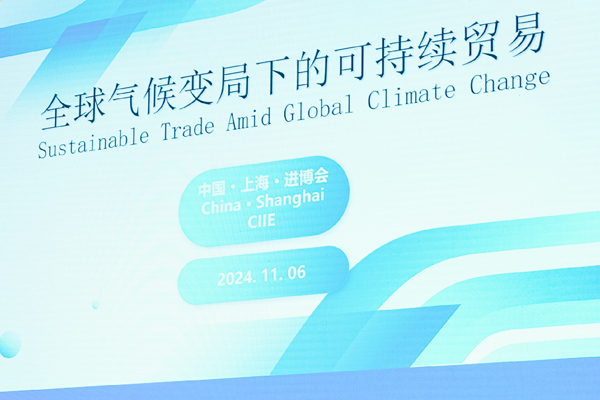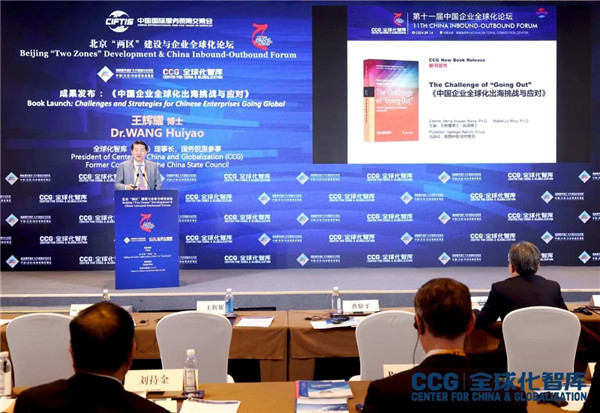CCG releases 2020 Bluebook Report on Chinese Enterprise Globalization
July 08 , 2020
Recently, the Center for China and Globalization (CCG) released the 2020 Bluebook Report on Chinese Enterprise Globalization. Co-authored by CCG and the Development Research Institute of Southwestern University of Finance and Economics, this report was edited by Wang Huiyao, CCG president and dean of the Development Research Institute of Southwestern University of Finance and Economics, as well as Miao Lu, CCG secretary-general, and published by the Social Sciences Academic Press of the Chinese Academy of Social Science.
The report summarizes and analyzes the overseas development of Chinese enterprises in a comprehensive way and provides new perspectives on the research of transnational corporations’ investment in China. This is the sixth consecutive year that CCG has released an annual report on this topic.
The report is composed of six chapters: General Summary, Rankings, Surveys, Key Issues, Case Studies, and the Appendix. The report summarizes the situation, characteristics and trends of global Foreign Direct Investment (FDI), outbound investment by Chinese enterprises, and foreign investment in China in 2018 and 2019. Based on data analysis, the report provides theoretical and practical guidance on how Chinese enterprises can deal with the complex international situation, respond accordingly when developed economies of Europe and the US tighten up foreign investment review, and make investments in the US, especially amidst continuing China-US trade frictions, as well as issues regarding the sustainable development of the Belt and Road Initiative and the high-quality development of overseas economic and trade cooperative areas.
In the Rankings chapter, the research group shares two perspectives on studies about outbound investment by Chinese enterprises and foreign investment in China from 2018 to the first half of 2019. The report was based on methods like on-site investigation, questionnaires, telephone interviews, data collection from regular activities such as thematic forums, seminars, and news media monitoring. By measuring investment size, impact, and development potential as key factors, the research group, through expert reviews, comprehensively selected and promoted the “2019 Top 10 Multinational Enterprises to Invest in China” and “Top 10 Chinese Enterprises on Globalization.”
In the Surveys chapter, through forums such as the “China Inbound-Outbound Forum” and “China and Globalization Forum,” which brought together many political and business experts to discuss topical issues, the research group put together the opinions of scholars and entrepreneurs to explore the realities and existing problems of Chinese enterprises “going global,” and analyze foreign investments in a new era after the introduction of China’s new Foreign Investment Law.
The Key Issues chapter presents an in-depth discussion on the impact of the institutional environment of international investment on enterprise investment, how enterprises can improve investment quality and efficiency facing a complicated overseas investment situation, the legal issues faced by Chinese enterprises in overseas development, the evolution of investment facilitation issues, the ways and means of Chinese enterprises investing in the US, the construction of domestic international industrial parks, investment and cooperation opportunities in Japan, and other issues.
In the Case Studies chapter, the research group selected classic cases of multinational companies and Chinese enterprises “going global,” namely CST China, China Communications Construction, and Volare Lusso. By analyzing and interpreting the cases, the report offers reference and experiences for the overseas development of enterprises.
Lastly, the Appendix chapter summarizes the outbound investment events in 2018 and 2019 collected by CCG, to shed light on the overseas development of Chinese enterprises.
The following are some highlights of CCG’s 2020 Bluebook Report on Chinese Enterprise Globalization:
1.The current status and characteristics of global FDI in 2018 and 2019
Since 2018, the world has seen severe challenges for globalization, trade tensions, increasing geopolitical risk, and many other troubling issues. International organizations such as the United Nations (UN), the International Monetary Fund (IMF) and the World Bank revised forecasts for global growth downwards time after time. Affected by the negative impacts of the COVID-19 pandemic, the IMF expects the world economy will shrink by 4.9% in 2020, and that the growth rate in developed economies will be -8%, with a deep recession in the United States, Japan, Britain, Germany, France, Italy and Spain.
Besides, the outlook for global FDI is full of uncertainty because of the pandemic. The World Investment Report 2020 by the United Nations Conference on Trade and Development (UNCTAD) expects that global FDI will be lower than $1 trillion this year, which is the lowest level since 2005. Prospects for investment depend on the duration of the pandemic, as well as the effectiveness of policies on alleviating the impacts of the pandemic on the economy. Countries, especially developed economies of Europe and America, hold a cautious attitude towards foreign investment, and the restrictive measures on foreign investments have reached a high point over the years.
2.The characteristics of China’s overseas investment in 2018 and 2019
The report shows that in 2018 and 2019, amidst a complex international context, the overall global investment of Chinese enterprises has developed steadily, the global share of FDI stocks has continuously increased, the industrial structure of overseas mergers and acquisitions has become more diversified, and the performance of foreign investment in manufacturing, communications, computer services and software industries stands out in particular. China’s investment in the BRI and other countries has been promoted significantly, and the proportion of Chinese enterprises’ foreign investment has been increasing.
Based on the analysis of global and Chinese enterprises’ foreign investment, the report summarizes five major problems encountered in the development of Chinese enterprise globalization and gives five recommendations.
1)Problem 1: the complex international situation has brought great uncertainty to the overseas development of Chinese enterprises.
The report suggests that the government, enterprises and third-party service agencies should work together to manage the risks of foreign investment, and explore investment opportunities of emerging countries in Asia, Africa, and Latin America.
2)Problem 2: Foreign investment review in developed countries in Europe and the US is becoming more and more strict, and Chinese enterprises have become the focus of the review.
The report suggests that enterprises need to strengthen the front-end layout of overseas investment in high-tech fields; by taking some steps such as setting up research centers overseas, enterprises should make full use of the excellent scientific and technological talent of developed countries to connect with global cutting-edge technologies.
3)Problem 3: Some in European countries and America have misunderstandings and doubts about the BRI.
The report suggests strengthening the BRI under the multilateral structure, promoting multilateral cooperation to bridge gaps; encouraging and supporting small and medium-sized enterprises to participate in the BRI; giving full play to the role of the market in resource allocation; as well as promoting the sustainable development of the BRI with market-oriented forces.
4)Problems 4: while Chinese Overseas Economic and Trade Cooperation Zones (COCZs) have made remarkable achievements, there are some development bottlenecks, including that leading industries are mainly concentrated in traditional labor-intensive and resource-intensive industries, with few leading industries with high industrial added value and high technology content, and also that COCZs meet some challenges in funding, supporting services and other factors.
The report suggests, firstly, actively promoting the transformation and upgrading of COCZs, increasing the proportion of high value-added industries, and forming a supporting industrial chain of upstream, midstream and downstream development; secondly, establishing and improving the long-term communication and coordination mechanism of bilateral governments based on the vision of consultation, cooperation and benefit for all, fully mobilizing host governments to participate in the construction of economic and trade cooperation zones, and establishing policies to support the smooth development of the economic and trade cooperation zone; thirdly, increasing funding and support for talent and supporting services.
5)Problem 5: After several twists and turns, the China-US trade dispute has not only damaged the economic interests of the US, but also affected China’s economic growth rate, slowed down economic rebalancing process, and hurt global growth.
The report makes a range of suggestions, including improving accounting methods for China-US trade to more accurately and fairly reflect the value gained by both countries, including trade in services, tourism, and study abroad; improving implementation details for China’s Foreign Investment Law, boosting actions to attract foreign investment, and addressing US concerns about Chinese legal issues; continuing to uphold the multilateral trade system, using multilateral cooperation to promote WTO reform, and evaluating the opportunity for China to join the CPTPP; strengthening further ties between Chinese and US businesses to prevent decoupling; strengthening China-US people-to-people relations and enhancing non-governmental diplomacy with think tanks, trade associations and NGOs; and enhancing the role of “sub-national diplomacy” by actively strengthening cooperation with US state and municipal governments.
3.Foreign investment environment in China in 2018 and 2019
With globalization facing severe challenges, global trade and foreign investment faced downwards pressure in 2019. As the world’s second-largest economy, China firmly upholds economic globalization and actively advances opening-up, including by:
1)China firmly upholds multilateral trading system by building a platform for international cooperation——the Belt and Road Forum for International Cooperation to maintain an open world economy, to promote the establishment of a fair and reasonable international economic and trade system, and to promote building a community of common destiny for humankind.
2)China has strengthened the protection of the legitimate rights and interests of foreign investment through the promulgation of China’s Foreign Investment Law, and created a more favorable investment environment for foreign investors by introducing a series of policies such as the Special Administrative Measures (Negative List) for Access of Foreign Investment and the Special Administrative Measures (Negative List) for Foreign Investment Access in Pilot Free Trade Zones.
3)Through the establishment of 18 pilot free trade zones in the past seven years, China has actively explored the construction of free trade ports and built a global cooperation platform.
4.The trend of foreign investment in China
In the short run, China’s inbound and outbound investment will be affected by COVID-19. In the long run, China is still an attractive destination for foreign investment, with increasing openness, effective implementation of investment facilitation policies, huge and sustained economic growth, good infrastructure, rich human resources, and strong industrial supporting capacity. The report outlines several future trends for foreign investment in China:
1)China is committed to advancing opening-up to a higher level. With the continuous improvement of the investment environment, the scale of foreign investment is expected to remain stable.
2)Improving the quality of foreign investment is a new direction for China to use foreign capital, and the high-tech industry will become an important direction for foreign investment in China.
3)The regional distribution pattern of foreign investment in China is expected to be more balanced.
4)The types of foreign investment enterprises in China will be more diversified, with sole ownership most favored by foreign investors.
5)The pilot free trade zone and free trade port will become a new hotspot for foreign investment in China.
5.Rankings
By measuring investment size, impact and development potential as key factors, the report issued two rankings, including “2019 Top 10 Multinational Enterprises to Invest in China” and “Top 10 Chinese Enterprises on Globalization.”
2019 Top 10 Multinational Enterprises to Invest in China were Allianz Group, BASF SE, BMW AG, Daimler AG, Mars Incorporated, Merck KGaA, Exxon Mobil Corporation, UBS Group AG, Samsung Electronics Co., Ltd. and Tesla, Inc.
Top 10 Chinese Enterprises on Globalization were Alibaba Group Holding Limited, Beijing Rice Technology Co., Ltd., Fuyao Glass Industry Group Co., Ltd., Huawei Investment & Holding Co., Ltd., JD.com, Lenovo Holding Co., Ltd., Qingdao Haier Technology Co Ltd., Shenzhen Tencent Computer System Co., Ltd., New Hope Group Co., Ltd., and Zhejiang Geely Holding Group Co., Ltd.






